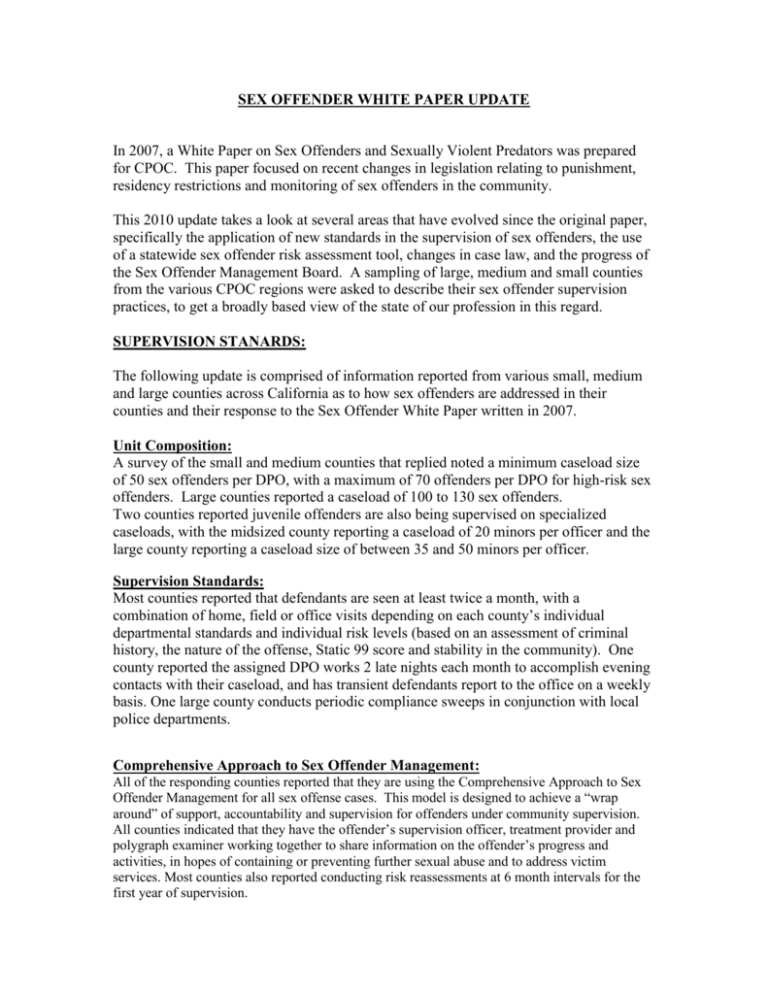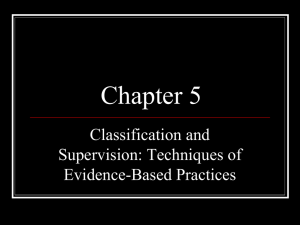SEX OFFENDER WHITE PAPER UPDATE
advertisement

SEX OFFENDER WHITE PAPER UPDATE In 2007, a White Paper on Sex Offenders and Sexually Violent Predators was prepared for CPOC. This paper focused on recent changes in legislation relating to punishment, residency restrictions and monitoring of sex offenders in the community. This 2010 update takes a look at several areas that have evolved since the original paper, specifically the application of new standards in the supervision of sex offenders, the use of a statewide sex offender risk assessment tool, changes in case law, and the progress of the Sex Offender Management Board. A sampling of large, medium and small counties from the various CPOC regions were asked to describe their sex offender supervision practices, to get a broadly based view of the state of our profession in this regard. SUPERVISION STANARDS: The following update is comprised of information reported from various small, medium and large counties across California as to how sex offenders are addressed in their counties and their response to the Sex Offender White Paper written in 2007. Unit Composition: A survey of the small and medium counties that replied noted a minimum caseload size of 50 sex offenders per DPO, with a maximum of 70 offenders per DPO for high-risk sex offenders. Large counties reported a caseload of 100 to 130 sex offenders. Two counties reported juvenile offenders are also being supervised on specialized caseloads, with the midsized county reporting a caseload of 20 minors per officer and the large county reporting a caseload size of between 35 and 50 minors per officer. Supervision Standards: Most counties reported that defendants are seen at least twice a month, with a combination of home, field or office visits depending on each county’s individual departmental standards and individual risk levels (based on an assessment of criminal history, the nature of the offense, Static 99 score and stability in the community). One county reported the assigned DPO works 2 late nights each month to accomplish evening contacts with their caseload, and has transient defendants report to the office on a weekly basis. One large county conducts periodic compliance sweeps in conjunction with local police departments. Comprehensive Approach to Sex Offender Management: All of the responding counties reported that they are using the Comprehensive Approach to Sex Offender Management for all sex offense cases. This model is designed to achieve a “wrap around” of support, accountability and supervision for offenders under community supervision. All counties indicated that they have the offender’s supervision officer, treatment provider and polygraph examiner working together to share information on the offender’s progress and activities, in hopes of containing or preventing further sexual abuse and to address victim services. Most counties also reported conducting risk reassessments at 6 month intervals for the first year of supervision. Static 99 Assessment/ GPS Monitoring: All counties that responded have informed that they are utilizing the STATIC 99 risk assessment tool to determine risk levels for adult male sex offenders. Probationers are then seen based upon this risk level and the need for GPS monitoring is explored. Some counties place high risk offenders with a risk score of 6 or higher on GPS, Some counties place all offenders on GPS, another county uses GPS monitoring of offenders determined by non compliant behaviors. Offenders on GPS are typically monitored daily by the supervision officer. These changes relate directly to the 2006 passage of Senate bills 1178 and 1128, and Assembly bill 1849. These statutes require the risk assessment of all sex offender registrants on probation, regardless of their current offense, beginning in July 2008. Effective January 2009, high-risk sex offenders (a score of 6 or higher on the Static 99) on probation must be supervised using intensive and specialized methods, to include high-tech and proven electronic monitoring. One large county is moving forward on a fully staffed 24/7 GPS monitoring center. Sex Offender Specific Terms of Probation: All reporting counties indicated probation terms and conditions are recommended that are relative to the defendant’s case. Sex Offender specific terms are routinely requested to assist in providing adequate supervision to the offender once granted probation and include terms such as: limitations on any possession of pornography, limits on access to specific internet social websites, disclosure to the supervision officer of all email addresses, passwords and membership websites, counseling and therapy specific to sex offenders, polygraph examinations, no contact with minors etc. One large county reported having a specially trained forensic officer who conducts searches of computers and cell phones in order to closely monitor compliance with these specialized terms and conditions. CASE LAW: An update on that state of the law regarding sex offenders was sought from Janet Neely, Deputy Attorney General. She provided the following: Most resent case law update In People v. Corona (2008) 160 Cal.App.4th 315 it was held that a sex offender placed in a high risk sex offender treatment program as a condition of parole could not be required to waive his psychotherapist-patient privilege as to his private therapist (as opposed to the state-mandated group therapist). However, if the parole conditions had expressly noted that this waiver was required as a condition of parole, rather than generally specifying that participation was required in a high risk program, it might have withstood scrutiny. The Comprehensive Approach to Sex Offender Management requires close cooperation and communication between treating therapist and parole/probation officer. Consequently, the probation and parole conditions should always include a requirement of waiver of the psychotherapist-patient privilege for the period of supervision, with both state-mandated and private therapist as well as the polygraph examiner. Otherwise, the person could be sexually reoffending, considering reoffending, accessing victim populations, or other risky behavior, and the therapist would not be able to communicate that fact to the probation or parole officer. County’s responses to Megan and Jessica’s Law: Some Probation departments are not yet enforcing Megan’s Law with regards to noticing the public where a defendant resides. Many counties defer to local law enforcement to make the required public notifications. Most counties are not yet enforcing Jessica’s Law with regards to the 2000-foot limitations, due to a case challenging the restriction. That matter, a collection of four cases of parolees challenging the state’s imposition of the 2000-foot restriction, is known as “the EJ cases” after one of the plaintiffs. It is set for argument before the state Supreme Court. Update: On 2-2-10, the California Supreme Court tentatively upheld the retroactive application of Jessica’s law by a 5-2 majority. However, the court asked for more arguments on the 2000 foot residency rule and the central argument that the law is overly restrictive and violates the rights of convicted sex offenders. It did continue the stay order prohibiting enforcement of the law against the 4 plaintiffs. So far, the cases under review appear to be primarily parolee matters and revolve around the issues of the retroactivity or ex post facto applicability of the restriction, as it applies to the dates of conviction of the sex crime, conviction of the present crime, release on parole, or appropriation of the property. Whether these cases will resolve questions about the applicability of the restriction to probationers is unknown. CALIFORNIA SEX OFFENDER MANAGEMENT BOARD To assess the progress and status of the California Sex Offender Management Board, board member Catherine Duggan was contacted by telephone. Ms. Duggan is also the Director of the Crime Victims Assistance Division for Ventura County’s District Attorney’s office. She related that the Board’s activities have been focused on the supervision of sex offenders, particularly on issues of recidivism, treatment, and housing. Ms. Duggan reported that the Sex Offender Management Board supports the use of the Comprehensive Approach to Sex Offender Management for community supervision, and the establishment of a standardized, statewide set of criteria for sex offender therapists. Further, the board is examining a recommendation that offenders be placed on a 3-4 level tiered approach to supervision, with higher levels of scrutiny and restriction placed on offenders based on their offense and risk score on the Static 99 risk assessment tool. Ms. Duggan stated that the board has reviewed the issue of sex offender residency restrictions, particularly the 2000-foot restriction enacted in 2006 as Proposition 83, or Jessica’s Law, and found evidence that shows the restrictions are not related to an increase in community safety. She further noted that many communities are enacting local ordinances that are more restrictive than Jessica’s Law on sex offender housing. This has resulted in an increase in the number of parolees who report as “transient”, either as a way to evade the restriction or due to an earnest inability to find compliant housing. Ms. Duggan reported that the Sex Offender Management Board is aware that probation in California is generally not enforcing the 2000’ limit called for in Jessica’s Law, in large measure due to ambiguities as to its applicability. Regarding the use of GPS technology for high-risk sex offenders, the board is in support of this despite the opinion that it does not make much of a difference in the prevention of crime. The crime analysis aspect of tracking the behavior of sex offenders, however, is of value to the board. Ms. Duggan reported that the “sunset clause” governing the Sex Offender Management Board has been rescinded, and the board will continue to meet. Their next report is due to be published in January 2010. CONCLUSION While based on a sampling of counties and not full reporting, it appears that probation in California has adapted to the increased supervision standards called for by statute and initiative petition in 2006. The Comprehensive Approach to Sex Offender Management is a widely esteemed model of supervision and incorporates many of the collaborative themes used in probation prior to the sex offender statues, and meets the standards of “intensive and specialized” set in the law. Static 99 assessment of adult males appears to be fully implemented, as does the GPS supervision of high-risk offenders. It is clear from the lack of a uniformity of application and the pending cases before the Appellate and Supreme Courts that there are issues that still need resolution two years after the passage of the legislative and initiative measures.








